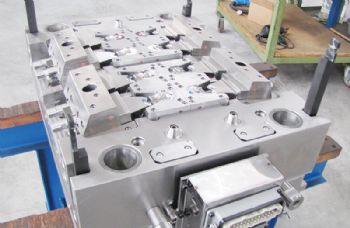
Based in a 2,000m
2 facility in Treviso, Italy, Mecca TP is a mould maker that produces mould tools for thermo-plastic materials and die-castings; these tools are used by a variety of industry sectors, including medical, automotive, household appliances, furniture and eyewear.
Co-owner Antonio Tognon says that the company’s moulds have to be produced both quickly and accurately and must be ‘right first time’, with no need to change them unless requested by the customer.
He relies on the specialist VISI Analysis module from Cobham-based (Surrey) Hexagon Manufacturing Intelligence (
www.HexagonMI.com) to discover critical areas at an early stage of the design process.
Mr Tognon says: “Using VISI to design and machine our mould tools means we can guarantee that they will give a high mechanical performance with precision movements, along with a high aesthetic quality of the moulded products — for long periods of production.
“We work closely with customers to design the finished moulded products.
“We will also reverse-engineer parts and even reconstruct damaged mechanical parts; and if there is no design documentation, we will create it.
“Furthermore, we have developed our production processes over the years to minimise the amount of manual intervention when machining moulds.”
He says the company has always adopted the most advanced technologies, from two- and four-axis wire EDM to high-speed three- and five-axis milling — plus VISI CAD/CAM software.
Indeed, Mr Tognon says this has been key to ensuring that the moulds are consistently manufactured to the high levels of precision required — from the design process through to them being machined.
Software solutions
Mecca TP produces between 40 and 80 moulds a year, ranging in size from 200 x 200 x 200mm to 600 x 800 x 700mm.
The company uses VISI Mould for mould design, while electrodes are modelled and machined using VISI Machining 3D; this is also used for cutting plates and moulding parts, along with Machining Strategist and VISI Wire.

Mr Tognon says: “Our in-house team follows the mould design, adopting various solutions for mould movements and conditioning circuits, as well as injection and extraction systems.
“In order to optimise the final product and the moulding process, we pay precise attention to VISI Analysis and the possible improvements that the software proposes.”
He says this is used in the preliminary stage, before the design process begins, to analyse details such as drafts, undercuts and thicknesses “and to establish possible dimensions of the finished moulds.
“We import customer STEP, IGES or Parasolid files and analyse the geometry in depth to establish the quality of the mathematical model, while correcting incomplete or inaccurate geometries.
“We then move on to create the ‘mould basement’ and define details, before sending the component parts to the different CAM stations for milling, wire cutting, and electrode modelling and construction.”
Offering an example of Mecca TP’s capabilities, Mr Tognon offers the example of a stainless-steel mould that the company developed to replace an existing mould used by a medical-sector client.
“The mould was to produce a small circular component with a diameter of about 40mm.
“The part had to be moulded in a ‘white chamber’ with eight impressions, in a complete ‘discharge cycle’ of less than 20sec.”
Design change
Mr Tognon described the product as being complex, with irregular surfaces and a different finish on the front and back (one side required a shiny mirror-like surface).

“We created a completely new type of mould movement that was very different from the one originally being used by the customer; and while our optimised design ensured the highest level of productivity, each imprint now also has a completely interchangeable matrix and punch.
“These are fixed to the mould by screws, which means we can replace them when they are worn out, without changing the entire mould — even if the mould is inside the machine.
“This interchangeability also means we can produce different products using the same basic mould.
“The main challenge with this mould was finding a way to obviate undercuts, while also designing the mould movements required to ensure that we achieved high-quality parts in the soft adhesive PVC material specified — and minimising wastage.
“By using VISI Analysis, we were able to use its advanced mathematics to identify critical areas at the start of the project.
“This greatly simplified our work and resulted in a significant reduction in our design and production times.
“VISI Mould handles the entire design process, providing our team with design automation that guided them throughout the project’s development; and with immediate access to numerous catalogues of main suppliers’ components, we had everything we needed ‘at our fingertips’.
“VISI optimises the entire process from design to delivery, allowing us to continually meet increasingly tight delivery times.”